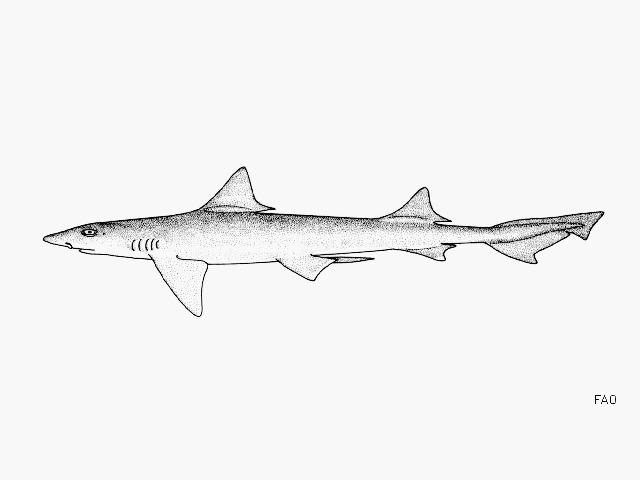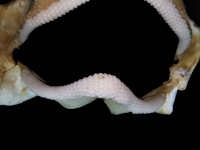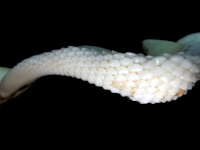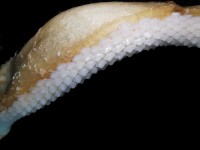Mustelus mustelus
(Linnaeus, 1758)
Smooth-hound
Classification: Elasmobranchii Carcharhiniformes Triakidae
Reference of the original description
Systema Naturae per regna tria naturae, regnum animale, secundum classes, ordines, genera, species, cum characteribus differentiis synonymis, locis. Tomus I. Editio decima, reformata. Stockholm, Laurentii Salvii, 824pp.
Systema Naturae per regna tria naturae, regnum animale, secundum classes, ordines, genera, species, cum characteribus differentiis synonymis, locis. Tomus I. Editio decima, reformata. Stockholm, Laurentii Salvii, 824pp.
Image of the original description
No image in first description.
No image in first description.
Synonyms / new combinations and misspellings
Galeorhinus laevis, Galeorhinus mustelus, Galeus asterias, Galeus laevis, Galeus mustellus, Galeus mustelus, Murmille mustelus, Mustelus cf. mustelus, Mustelus equestris, Mustelus laevis, Mustelus vulgaris, Myrmillo mustelus, Pleuracromylon laevis, Squalus mustellus, Squalus mustelus
Galeorhinus laevis, Galeorhinus mustelus, Galeus asterias, Galeus laevis, Galeus mustellus, Galeus mustelus, Murmille mustelus, Mustelus cf. mustelus, Mustelus equestris, Mustelus laevis, Mustelus vulgaris, Myrmillo mustelus, Pleuracromylon laevis, Squalus mustellus, Squalus mustelus
Types
Mustelus mustelus
XXXX: No types known;
Galeus laevis
XXXX: No types known;
Mustelus equestris
Lectotype: ANSP: 617 (old: Bonaparte 248); Paralectotype: ANSP: 618 (old: Bonaparte 248, ANSP 618-620);
Mustelus laevis
XXXX: No types known;
Mustelus vulgaris
XXXX: No types known;
Mustelus mustelus
XXXX: No types known;
Galeus laevis
XXXX: No types known;
Mustelus equestris
Lectotype: ANSP: 617 (old: Bonaparte 248); Paralectotype: ANSP: 618 (old: Bonaparte 248, ANSP 618-620);
Mustelus laevis
XXXX: No types known;
Mustelus vulgaris
XXXX: No types known;
Description :
Citation: Mustelus mustelus (Linnaeus, 1758): In: Database of modern sharks, rays and chimaeras, www.shark-references.com, World Wide Web electronic publication, Version 12/2025
Please send your images of "Mustelus mustelus" to info@shark-references.com

Mustelus mustelus (Linnaeus, 1758), © FAO, www.fish-base.org

Mustelus mustelus (Linnaeus, 1758), © FAO, www.fish-base.org
Common names
 Gemeiner Südlicher Glatthai,
Gemeiner Südlicher Glatthai,  Glatthai,
Glatthai,  Grauer Glatthai,
Grauer Glatthai,  Hundshai,
Hundshai,  Mittelmeer-Glatthai,
Mittelmeer-Glatthai,  Südlicher Glatthai,
Südlicher Glatthai,  Boca blanca,
Boca blanca,  Cazón,
Cazón,  Musola,
Musola,  Musola gavatia,
Musola gavatia,  Musola pintada,
Musola pintada,  Musola vera,
Musola vera,  Tollo,
Tollo,  Chien de mer,
Chien de mer,  Emissole lisse,
Emissole lisse,  Galéos,
Galéos,  Gat roumillon,
Gat roumillon,  Lentillat,
Lentillat,  Missole,
Missole,  Mustèle vulgaire,
Mustèle vulgaire,  Palloun,
Palloun,  Émissole lisse commune,
Émissole lisse commune,  Gray mouth dog,
Gray mouth dog,  Houndshark,
Houndshark,  Smooth dogfish,
Smooth dogfish,  Smooth hound,
Smooth hound,  Smooth-hound,
Smooth-hound,  Smoothhound,
Smoothhound,  Stellate smooth-hound,
Stellate smooth-hound,  Sweet William,
Sweet William,  Cagneto,
Cagneto,  Cagnoleto,
Cagnoleto,  Cagnoletto,
Cagnoletto,  Can,
Can,  Cane,
Cane,  Cialestru,
Cialestru,  Gattone,
Gattone,  Mussola,
Mussola,  Nisseua,
Nisseua,  Nissoa,
Nissoa,  Nocciolo,
Nocciolo,  Palombo,
Palombo,  Palombo comune,
Palombo comune,  Palombo liscio,
Palombo liscio,  Palombo nocciolo,
Palombo nocciolo,  Palumme,
Palumme,  Palumme verace,
Palumme verace,  Palummu,
Palummu,  Penn,
Penn,  Penne,
Penne,  Stire,
Stire,  Caneja,
Caneja,  Caneja-lisa,
Caneja-lisa,  Caçao,
Caçao,  Cação liso ou Caneja,
Cação liso ou Caneja,  Cação-branco,
Cação-branco,  Cação-liso,
Cação-liso,  Cação-pique,
Cação-pique,  Corre-costa,
Corre-costa,  Galhudo, Mazzola bla xewka (malta)
Galhudo, Mazzola bla xewka (malta)
 Gemeiner Südlicher Glatthai,
Gemeiner Südlicher Glatthai,  Glatthai,
Glatthai,  Grauer Glatthai,
Grauer Glatthai,  Hundshai,
Hundshai,  Mittelmeer-Glatthai,
Mittelmeer-Glatthai,  Südlicher Glatthai,
Südlicher Glatthai,  Boca blanca,
Boca blanca,  Cazón,
Cazón,  Musola,
Musola,  Musola gavatia,
Musola gavatia,  Musola pintada,
Musola pintada,  Musola vera,
Musola vera,  Tollo,
Tollo,  Chien de mer,
Chien de mer,  Emissole lisse,
Emissole lisse,  Galéos,
Galéos,  Gat roumillon,
Gat roumillon,  Lentillat,
Lentillat,  Missole,
Missole,  Mustèle vulgaire,
Mustèle vulgaire,  Palloun,
Palloun,  Émissole lisse commune,
Émissole lisse commune,  Gray mouth dog,
Gray mouth dog,  Houndshark,
Houndshark,  Smooth dogfish,
Smooth dogfish,  Smooth hound,
Smooth hound,  Smooth-hound,
Smooth-hound,  Smoothhound,
Smoothhound,  Stellate smooth-hound,
Stellate smooth-hound,  Sweet William,
Sweet William,  Cagneto,
Cagneto,  Cagnoleto,
Cagnoleto,  Cagnoletto,
Cagnoletto,  Can,
Can,  Cane,
Cane,  Cialestru,
Cialestru,  Gattone,
Gattone,  Mussola,
Mussola,  Nisseua,
Nisseua,  Nissoa,
Nissoa,  Nocciolo,
Nocciolo,  Palombo,
Palombo,  Palombo comune,
Palombo comune,  Palombo liscio,
Palombo liscio,  Palombo nocciolo,
Palombo nocciolo,  Palumme,
Palumme,  Palumme verace,
Palumme verace,  Palummu,
Palummu,  Penn,
Penn,  Penne,
Penne,  Stire,
Stire,  Caneja,
Caneja,  Caneja-lisa,
Caneja-lisa,  Caçao,
Caçao,  Cação liso ou Caneja,
Cação liso ou Caneja,  Cação-branco,
Cação-branco,  Cação-liso,
Cação-liso,  Cação-pique,
Cação-pique,  Corre-costa,
Corre-costa,  Galhudo, Mazzola bla xewka (malta)
Galhudo, Mazzola bla xewka (malta)
Short Description
Diagnosis after Compagno, 1984 [517]: Body fairly slender. Head short, prepectoral length 17 to 21% of total length; snout moderately long and bluntly angular in lateral view, preoral sno, 5.3 to 7.4% of total length, preorbital snout 5.9 to 8% of total length; internarial space broad, 2.4 to 3% of total lenght eyes fairly large, eye length about 1.9 to 2.8 times in preorbital snout and 2.3 to 4% of total length; interorbital space narrow, 3.7 to 4.8% of total length; mouth fairly short, length subequal to eye length and 2.2 to 3.5% of total length; upper labial furrows usually slightly longer than lowers and 1.4 to 2.1% of total length; teeth molariform and asymmetric, with cusp reduced to a low point, cusplets absent except in very young sharks; buccopharyngeal denticles confined to tongue tip and extreme anterior end of palate. Interdorsal space 18 to 25% of total length; trailing edges of dorsal fins denticulate, without bare ceratotrichia; first dorsal falcate, with posterior margin almost vertical, midbase closer to pectoral bases than pelvics; pectoral fins moderately large, length of anterior margins 13 to 17% of total length, width of posterior margins 8.2 to 14% of total length; pelvic fins moderately large, anterior margin 6.5 to 9.9% of total length; anal height 2.4 to 4.3% of total length; anal caudal space greater than second dorsal height, and 6.3 to 8.8% of total length; ventral caudal lobe more or less falcate in adults. Crowns of lateral trunk denticles lanceolate or weakly tricuspidate, with longitudinal ridges extending their entire length. Cranium and hyomandibulae not hypercalcified in adults, but scapulocoracoid .tips, distal pectoral radials, and hypochordal arches sometimes slightly hypercalcified; palatoquadrates not subdivided; monospondylous precaudal centra 25 to 32, diplospondylous precaudal centra 40 to 66, precaudal centra 70 to 93. Colour uniform grey or grey-brown, above, light below, no white spots or dark bars, some specimens with dark spots. Development viviparous. Size large, adults 70 to at least 164 cm.
Diagnosis after Compagno, 1984 [517]: Body fairly slender. Head short, prepectoral length 17 to 21% of total length; snout moderately long and bluntly angular in lateral view, preoral sno, 5.3 to 7.4% of total length, preorbital snout 5.9 to 8% of total length; internarial space broad, 2.4 to 3% of total lenght eyes fairly large, eye length about 1.9 to 2.8 times in preorbital snout and 2.3 to 4% of total length; interorbital space narrow, 3.7 to 4.8% of total length; mouth fairly short, length subequal to eye length and 2.2 to 3.5% of total length; upper labial furrows usually slightly longer than lowers and 1.4 to 2.1% of total length; teeth molariform and asymmetric, with cusp reduced to a low point, cusplets absent except in very young sharks; buccopharyngeal denticles confined to tongue tip and extreme anterior end of palate. Interdorsal space 18 to 25% of total length; trailing edges of dorsal fins denticulate, without bare ceratotrichia; first dorsal falcate, with posterior margin almost vertical, midbase closer to pectoral bases than pelvics; pectoral fins moderately large, length of anterior margins 13 to 17% of total length, width of posterior margins 8.2 to 14% of total length; pelvic fins moderately large, anterior margin 6.5 to 9.9% of total length; anal height 2.4 to 4.3% of total length; anal caudal space greater than second dorsal height, and 6.3 to 8.8% of total length; ventral caudal lobe more or less falcate in adults. Crowns of lateral trunk denticles lanceolate or weakly tricuspidate, with longitudinal ridges extending their entire length. Cranium and hyomandibulae not hypercalcified in adults, but scapulocoracoid .tips, distal pectoral radials, and hypochordal arches sometimes slightly hypercalcified; palatoquadrates not subdivided; monospondylous precaudal centra 25 to 32, diplospondylous precaudal centra 40 to 66, precaudal centra 70 to 93. Colour uniform grey or grey-brown, above, light below, no white spots or dark bars, some specimens with dark spots. Development viviparous. Size large, adults 70 to at least 164 cm.
Distribution
Eastern Atlantic: British Isles and France to South Africa, including the Mediterranean, Madeira and the Canary Islands. Often referred to as Mustelus canis which is restricted to the western Atlantic. Source: www.gbif.org
Eastern Atlantic: British Isles and France to South Africa, including the Mediterranean, Madeira and the Canary Islands. Often referred to as Mustelus canis which is restricted to the western Atlantic. Source: www.gbif.org
Human uses
fisheries: highly commercial; gamefish: yes; price category: medium; price reliability: reliable: based on ex-vessel price for this species
fisheries: highly commercial; gamefish: yes; price category: medium; price reliability: reliable: based on ex-vessel price for this species
Biology
Viviparous, with a yolk-sac placenta; 4 to 17 (Ref. 39938) young in a litter. Size at birth about 39 cm. Distinct pairing with embrace [17086]. Found on the continental shelves and uppermost slopes, from the intertidal region to at least 350 m depth [517]. Collected to depth of 624 m in the eastern Ionian Sea [17735]. Sometimes in midwater but prefers to swim near the bottom [517]. Feeds mainly on crustaceans, but also cephalopods and bony fishes [517].
Viviparous, with a yolk-sac placenta; 4 to 17 (Ref. 39938) young in a litter. Size at birth about 39 cm. Distinct pairing with embrace [17086]. Found on the continental shelves and uppermost slopes, from the intertidal region to at least 350 m depth [517]. Collected to depth of 624 m in the eastern Ionian Sea [17735]. Sometimes in midwater but prefers to swim near the bottom [517]. Feeds mainly on crustaceans, but also cephalopods and bony fishes [517].
Remarks
shark-references Species-ID=3811;
shark-references Species-ID=3811;
Parasites (arranged by Jürgen Pollerspöck)
Conoidasida
Myxosporea
Monogenea
Cestoda
Trematoda
Nematoda
Copepoda
Isopoda
Conoidasida
- Goussia lucida Lom & Dyková, 1982 [32027]
Myxosporea
- Ceratomyxa sigmoidea Lisnerová, 2021 [30593]
- Ceratomyxa sphaerulosa Thélohan, 1892 [21233]
- Chloromyxum africanum Lisnerova, Martinek, Alama-Bermejo, Bouberlova, Schaeffner, Nkabi, Holzer & Bartosova-Sojkova, 2022 [31228]
- Sphaerospora alata Lisnerová, 2021 [30593]
Monogenea
- Calicotyle palombi Euzet & Williams, 1960 [17436] [21218] [7377] [23992]
- Calicotyle stossichi Braun, 1899 [17150] [17436] [7377] [23992] [31118]
- Erpocotyle catenulata (Guberlet, 1933) [17150] [7855] [31118] [31765]
- Erpocotyle laevis Van Beneden & Hesse, 1863 [22563] [15273]
- Erpocotyle macrohystera Price, 1942 [22589] [17150]
- Erpocotyle sp. [30559]
- Hexabothrium musteli (Maccallum, 1931) Price, 1942 [17150] [22550]
Cestoda
- Acanthobothrium coronatum (Rudolphi, 1819) Van Beneden, 1850 [16247] [16175] [16448] [28741]
- Acanthobothrium mathiasi Euzet, 1956 [16175] [16448] [28741]
- Calliobothrium verticillatum (Rudolphi, 1819) [19885] [16314] [22549] [21200] [29134]
- Coronocestus musteli (Pintner, 1889) [17123] [16430] [16430] [19536]
- Diesingium lomentaceum (Diesing, 1850) [23413] [16112] [15747]
- Dollfusiella vooremi (Sao Clemente & Gómes, 1989) [16112]
- Eutetrarhynchus ruficollis (Eysenhardt, 1829) [16303] [16112] [29720]
- Eutetrarhynchus sp. [21361]
- Gilquinia squali (Fabricius, 1794) [16112]
- Hepatoxylon megacephalum (Rudolphi, 1819) [16112]
- Hepatoxylon trichiuri (Holten, 1802) [16112]
- Lacistorhynchus tenuis (Van Beneden, 1858) [16303] [16112]
- Nybelinia sp. [16112]
- Otobothrium cysticum (Mayer, 1842) [16112]
- Phyllobothrium lactuca Van Beneden, 1850 [16443] [16443] [16443] [14629] [34140]
- Phyllobothrium sp. [21361]
- Prochristianella tumidula (Linton, 1890) [16112]
- Scyphophyllidium bai (Ruhnke & Carpenter, 2008) [7416]
- Scyphophyllidium musteli (Van Beneden, 1850) [16443]
- Scyphophyllidium triacis (Yamaguti, 1952) [16443]
- Symcallio eschrichti (Van Beneden, 1850) [16408] [21796]
- Symcallio leuckarti (Van Beneden, 1850) [16408] [16101] [17089] [21796]
- Symcallio lintoni (Euzet, 1954) [16314] [21796]
- Tetrarhynchobothrium striatum (Wagener, 1854) [16303] [16255] [16112]
Trematoda
Nematoda
- Acanthocheilus intermedius Orley, 1885 [17029]
- Acanthocheilus rotundatus (Rudolphi, 1819) [21418] [17029] [29134]
- Ascaris affins Örley, 1885 [17029]
- Cucullanus micropapillatus Tornquist, 1931 [21361]
Copepoda
- Achtheinus oblongus Wilson, 1908 [21498] [16547] [7660] [15303] [27172]
- Achtheinus pinguis Wilson, 1912 [27172]
- Alebion difficile (Van Beneden, 1892) [26820]
- Eudactylina insolens Scott & Scott, 1913 [16609]
- Eudactylinella alba Wilson, 1932 [27471] [30559]
- Kroyeria carchariaeglauci Hesse, 1878 [16609]
- Kroyeria lineata Van Beneden, 1853 [16601] [17867] [16609] [27471] [30559] [34815]
- Kroyeria sp. [27471] [30559]
- Lernaeopoda galei Krøyer, 1837 [16609] [15303] [21501] [27172] [27471] [30559]
- Lernaeopoda musteli Thomson, 1889 [29249]
- Nemesis robusta (Van Beneden, 1851) [16609]
- Nesippus orientalis Heller, 1868 [16609] [15284] [27172] [27471] [30559]
- Pandarus bicolor Leach, 1816 [15708] [33255]
- Perissopus dentatus Steenstrup & Lütken, 1861 [16609] [27471] [30559]
- Tripaphylus beatricae Dippenaar, 2017 [25960] [27172]
- Tripaphylus musteli (Van Beneden, 1851) [16609]
- Tripaphylus versicolor (Wilson, 1919) [16609]
Isopoda
- Anilocra physodes (Linnaeus, 1758) [30559]
- Ceratothoa parallela (Otto, 1828) [30559]
- Emetha audouini (H. Milne Edwards, 1840) [30559]
- Natatolana borealis (Lilljeborg, 1851) [29380]









.jpg)
.jpg)
.jpg)















